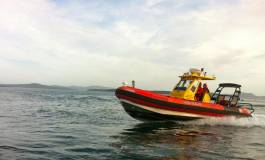





March 4th, 2005
March 4th, 2005
CCGA-P Junior Program
"It was kind of shocking to learn about the grim tasks that we might have to do, and how tough the working conditions can be." Franzmann is one of a few dozen junior candidates, aged 14 to 18 years, preparing for service in the Canadian Coast Guard Auxiliary - Pacific.The junior program, seen by CCGA-P as a farm-team of sorts that could help fill its future ranks of searchers and rescuers, gradually evolved from an idea in 1998 to a reality in about six of the auxiliarys four-dozen units by 2004. "It really happened by accident", according to Malcolm Dunderdale, CCGA-P President, "Some of our members kids expressed interest in the auxiliary, but we had concerns about liability. Most importantly, we didnt want them to be in harms way, so we developed strict guidelines governing their training and what roles they could have at their young ages."
Today most junior members are from non-auxiliarist families, attracted in part by unit recruiting advertisements or from a school counsellors suggestion, according to Curtis Bolton, leader, Unit #27 (Nanaimo). "The pre-requisites to join are simple - be responsible and safety-conscious. Boating experience isnt necessary."
Juniors must acquire the same qualifications as their adult counterparts, including radio operator and first aid certificates; pleasure craft operator card; proficiency in boat handling, search and rescue techniques, vessel maintenance, and navigation - and body recovery. "To maximize skills development the teens undergo specialized classroom and on-the-water instruction, and also participate in the regular unit training with adult members", said Ron Mellson, instructor, Unit #34 (Mill Bay). At age 17 years, juniors are allowed to crew on their units boat during real rescue missions. But, with the auxiliarys emphasis on incident prevention, units have many boating safety and education assignments available for even the youngest member.
With a quarter-century of service, Victoria-based CCGA-P comprises 1,400 volunteers and nearly 200 rescue boats in units around the BC coast and the Interior. It handles some 30% of the west coasts 3,000 annual marine incidents, which include fires, bridge-jumpers and collisions - more commonly mechanical problems; people overboard; medical emergencies; and vessels lost, aground, overdue or sinking. Some incidents are so disturbing that rescue crews require trauma counselling.
Many units use open-deck, rigid-hull inflatable (RHIB), fast-response boats, propelled by powerful twin outboard motors, and equipped with radar, global positioning system, and portable pumps. Crews are exposed to the elements, but they can respond at 40 knots. Not far from the southern concentration of multiple agencies and resources, units generally are alone with only their equipment and skill to rely upon. Regardless of locale, all units can face daunting weather and rigor ous operating conditions.
Many adolescent recruits have been around the water for large portions of their young lives, mainly through family boating. A few think theyll have some form of nautical career - marine biology, Coast Guard, tow boating or marine mechanics - but most of these high school students are likely to leave in pursuit of careers that may one day bring them back to their coastal roots. "Retaining them in the short term will be a challenge" said Dunderdale, "Some will continue straight into a CCGA-P unit as a regular member. Were hoping that the others will come back to us later."
Fifteen year-old Glen Waugh, from Duncan, is typical of many kids growing up around the water. "I learned to paddle a canoe at age five, and got my pleasure craft operators card at age 11." The grade ten student looks ahead to a career mess ing about with logging equipment and engines - heavy duty diesels - and expects to continue serving in his Coast Guard Auxiliary unit. "I hope that my work will allow me to stay close to home." What attracted him to the auxiliary? "Driving that fast RHIB was the first big attraction. It was also my first big challenge, learning the specific way the boat was to be driven, and mastering the high-speed maneuvers. Now I like navigating over driving. But, the hardest thing of all is searching for people because it takes lots of concentration, and during long searches it can get quite cold - especially with waves coming over the bow."
Jamie Franzmann, a grade nine student, felt a different motivation to join the auxiliary, and saw unique challenges in meeting the auxiliarys standards. "I did sports but it got boring, and I wanted something more serious. Here, there is so much to remember, especially navigational charting - good thing weve got erasers. The hardest physical parts of the work are rope handling, and using the boat hook to get a disabled boat ready for towing. Working in bad weather - wind, rain, darkness - can be tough, especially since my night vision isnt great." Franzmann is undecided about her career plans - maybe forensics, maybe Coast Guard- but she thinks that the auxiliary will remain a part of her life.
Seeing them whiz past on a sunny day, it looks like fun. Training in good weather is surreal, because troubles seem to happen only on blustery nights. Asked what advice she would offer anyone thinking of joining the Coast Guard Auxiliary, Franzmann said, "Be serious about the training, because the job to be done is very real."
Story by: Eric Manchester
Photos provided by:
Eric Manchester and
Barry Frenzmann
| RSS feed | Feed Description |
|---|---|
| Complete RSS feed | |
| RSS feed for: What´s New | |
| A Rich Site Summary (RSS) feed is an xml data file that provides a summary of the information contained here. It is not designed to be viewed in your browser, but instead by rss reader software. If you do not know what this means - you can safely ignore it, as it is provided for advanced users with rss reader software only. | |
